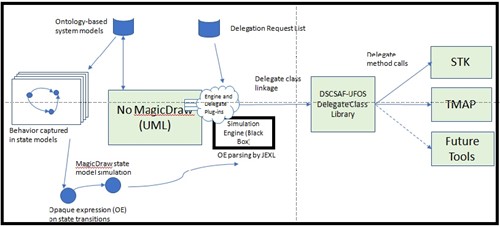Model-Based System Engineering (MBSE)
Model-Based System Engineering (MBSE) is an emerging systems engineering approach providing the next advance in Modeling, Simulation and Analysis (MS&A). Our MBSE efforts use Systems Modeling Language (SysML) as its modeling language. SysML is a domain-specific modeling language for systems engineering used to specify, analyze, design, optimize, and verify systems performance and behavior. Not only can the modeling language support the physics and engineering aspects of a system, but it can also capture how the warfighter might employ the system in a variety of scenarios and conditions.
DSoft Technology currently supports the Space Security and Defense Program (SSDP) conducting analysis of space and cyberspace capabilities, more specifically developing space engagement models to support MS&A of space warfighter effectiveness and performing sensitivity analysis of space warfighter and threat space engagements tactics relative to measures of space warfighter effectiveness (MoWE). These requirements require the ability to accurately simulate behaviors as interacting agents within a physics- based astrodynamics state environment, modeled as finite state machine representations, to simulate Orbital Engagement Mission Tactics (OEMT) and perform supporting analysis and examination of the parametric space for sensitivity discovery. In the past, analysts used agent-based simulations to describe and vary the behavior of the agents typically represented by scripting language which included system performance parameters, Concept of Operations (CONOPS), Concepts of Employment (CONEMPS) and Tactics, Techniques and Procedures (TTPs) to generate a realistic representation of a mission. Subject Matter Experts (SMEs) in various fields were required to describe the behaviors in sufficient detail through extensive interaction with software developers so that they could capture the behaviors. This transfer of information costs time due to many interpretations made resulting in tools never being ready to support the needed analysis. While this approach allowed for modeling specific behavior-based systems, it lacked the flexibility and robustness to manipulate the behaviors to explore many trade spaces quickly.
A solution that would formally describe the domain space, inclusive of the objects, concepts, and activities necessary to define the relationships and interactions of the domain problem space was needed. Using MBSE and specifically SysML, the agent models for simulation can be created that are well-structured and have actionable knowledge. The agents are represented in graphical form, allowing for visual vetting by SMEs of the dependencies and behavior logic. DSoft Technology builds the SysML models using NoMagic Cameo Systems Modeler (CSM). SysML Constraint blocks are used to specify a network of reusable constraints that represent mathematical expressions, which constrain the physical properties of a system (e.g. physics laws), behaviors (CONOPS, CONEMPS, TTPs) or calculate system MoEs (measure of effectiveness), e.g. cost, risk, performance, reliability, etc. Cameo Simulation Toolkit (a component of CSM) dynamically solves constraints in the context of full systems simulation and allows tracking and maintaining dependencies among critical parameters such as size, weight, speed, power, temperature and others throughout the system life cycle. The Paramagic Plugin allows performing parametric trade studies and "what-if " scenarios by swapping given and target values in SysML models, which capture alternatives, without modifying the parametric model. A huge amount of input values can be obtained from integrating MS Excel spreadsheets, calling other tools/models using scripting languages (JavaScript, Python, Ruby, etc.) or interfacing with CSM's built- in APIs to Matlab, Mathematica, Maple 18 and OpenModelica.
DSoft in support of SSDP is building both models of space systems that can be shared with other MS&A organizations such as the JWAC, NASIC, SMC and AFRL. By standardizing how space systems are modeled across these organizations, increased credibility and acceptance will be created in any analysis that is produced.

In a separate effort supporting SSDP, DSoft Technology is developing the Defensive Space Control Simulation Analysis Framework (DSCSAF) in combination with a Unifying Framework for Orchestration and Simulation (UFOS) engine that supports MS&A. The framework uses MBSE - Unified Modeling Language (UML) forms as the basis for the ontological knowledge and Java code that consumes/interprets the agent models that capture the doctrine, concepts, systems, and operational methods of interest. This language is presented graphically with an underlying meta-model facilitating consistent interpretation and automated execution/code generation. The structural elements provide the ability to capture performance and property-based information, while the behavioral elements allow for the representation of state machine and activity flows balanced by use-case descriptors. The DSCSAF-UFOS efforts have focused on building the UML ontological knowledge and ontological UML integration with delegates to other models and tools such as AGI's Systems Toolkit (STK) and NASIC's Threat Modeling and Analysis Program (TMAP) tools. The ontological knowledge serves as both documentation requirements and the execution of the simulation and analysis discovery. Direct manipulation of the agent performance and behaviors without any code changes allows for more efficient and timely analysis. The user can create new logic pathways and simply describe new transition criteria directly on the state machines or activity diagrams and execute again.
